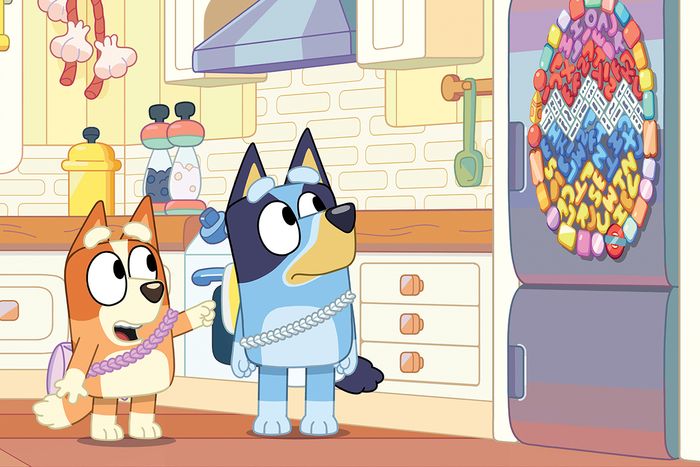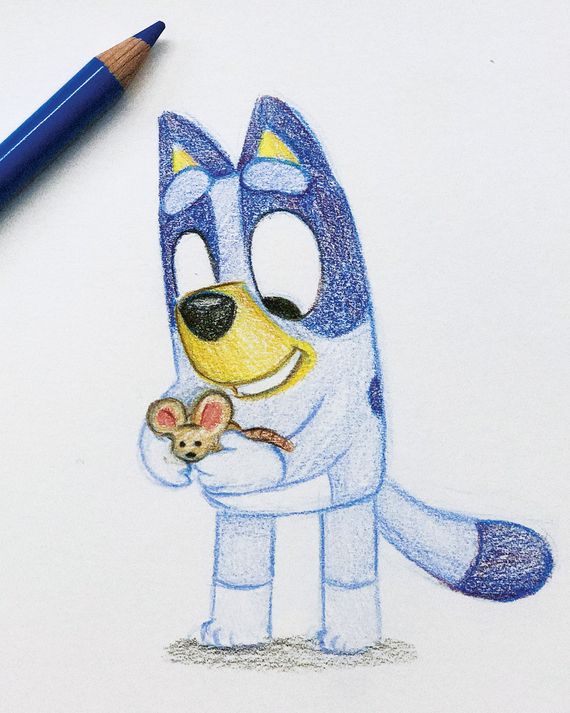
This article was originally published on May 23, 2021. We’ve republished it following the release of Bluey’s special episode “The Sign.”
I’m not great at playing with my kids. My 4-year-old loves to hand me stuffed animals and declare they are my new babies. She wants me to cuddle them, whisper to them, devote the next 40 minutes to the all-consuming care of a vaguely unicorn-like, rainbow-tufted sphere. She will be the babysitter, and I am the mama, and we will enter an endless cycle of putting the unicorn-ball baby to bed and waking it up. I can’t fully enter her headspace or shake the part of me that registers how absurd it is. I bristle at the repetition. At the end of most days, my desk is strewn with all the babies I was supposed to care for but had abandoned immediately. The unicorn’s giant embroidered sparkly eyes stare at me reproachfully.
So I watch the Australian children’s show Bluey with a mix of awe, wistfulness, love, and a dash of resentment. Bluey is about a family of cartoon dogs who live in Brisbane: a mom named Chilli; the dad, Bandit; and their two daughters, Bingo and Bluey, roughly ages 4 and 6. It’s really a show about Bluey and Bingo playing elaborate games with their parents and their friends, about the joy and strangeness of children’s imaginations and desires. Every streaming platform offers an endless list of animated children’s series following puppies solving problems, cartoon girls in wish-granting fairy-tale worlds, and heroes on adventures. All of it is about imagination, but almost none of it is all that imaginative. Bluey is the only one that knows how hilarious play can be, how silly and intense, how trivial but life-changing. I sincerely love watching it, unlike the countless kids’ shows I keep an eye on in the background or the ones I sit down to watch with my kids because the experts say shared screen time is the gold standard or whatever.
Bluey premiered in 2018 and swiftly became popular in Australia. It has been slower to catch on in the U.S. The show jumped in popularity when its 52-episode first season began streaming on Disney+ in January 2020, but the weekly release of Bluey’s incredible second season on the Disney Channel over the past year has changed the conversation from “What a good show” to “Oh my God, Bluey.” Last year, a number of TV critics put the series on their lists of the best TV of 2020, period. Episodes of its first season reached 16 million views in the U.S., and season two will become available to stream on Disney+ on May 28. As production begins on season three, the show feels as if it’s on the brink of broader global popularity. There are Bluey stuffed animals at Target now. This spring, I stood in a Hallmark store and contemplated whether to get my youngest daughter a Bluey book or a Bluey card game for her birthday.
Bluey has released over 100 episodes, each of which is seven minutes long. Its story lines are often small and domestic, the stuff instantly recognizable to kids everywhere who have been bored on a long car ride or struggled with a group of playmates who can’t quite figure out how to play together. My daughters fall into peals of laughter watching an episode like “Takeaway,” in which Bluey and Bingo wreak increasing havoc outside a restaurant while their dad waits for his order. As the episode escalates from a minor mess all the way up to spilled food and an emergency outdoor-toilet situation, my kids’ gasping, room-filling laughs incapacitate them. They laugh so hard I wonder if they’re hallucinating.
It registers differently with me. In “Cafe,” I watch the dad, Bandit, and wonder at his patience, his perpetual willingness to pretend to eat yet another imaginary hamburger, his constant readiness to play along. In “Sticky Gecko,” when Chilli struggles to get everyone out the door on time and eventually explodes in frustration, I feel as if I’ve been socked in the stomach. That was always part of creator Joe Brumm’s concept: If he was going to make a children’s show, he felt it should be legitimately entertaining and meaningful for parents, too.
There is a history of major leaps in children’s TV. The radical innovation of Mister Rogers’ Neighborhood was to see children as people, speaking directly to them and their concerns about the world. The revolution of Sesame Street was to weave educational material with a dramatization of a child’s city life. Bluey is a triumph of good-natured naturalism, a clarion understanding of what play really feels like and its importance in childhood. At the same time, every era gets children’s programming that reflects that generation’s ideas about parenting. Modern parents are supposed to be playmates — authority figures who are also engaged participants. So it’s fitting that Bluey achieves an unusual feat for children’s programming: a true double-vision viewing experience for parents and children watching together.
Brumm is the person most responsible for Bluey’s uncanny insight into kids. A charismatic, intensely focused dad in his 40s, he has messy hair that says “I’m not that interested in my hair” while also saying “Yeah, I know my hair looks pretty good.” He is not Mister Rogers, a cardigan-wearing role model who holds himself at a slight remove and plays carefully with puppets. That was a paternal aesthetic from another time. (Who has the time and energy for Mister Rogers’s meticulous hand-knit sweater, his beautiful, dirt-free loafers?) Brumm wears the uniform of the 2020s dad: a plain, slightly worn T-shirt and a deliberately scruffy face. He is blunt and wryly funny, but he speaks with the distinctly 21st-century care of someone who has thought a lot about how to be personal and forthcoming while remaining a fundamentally private person. When he tells stories about how his children play, he’s there in the stories too — on the floor with them, irritated, amused, exhausted. But they are feelings and situations he has already processed, considered, and prepared.
Brumm grew up in Queensland, Australia, and moved to the U.K. in the early aughts to pursue animation after college. He began working on British children’s shows, like the charming, idiosyncratic Charlie and Lola. When he moved back to Australia after a decade in the U.K., he founded a small studio that made both adult and children’s animation for CollegeHumor, the Australian Broadcasting Corporation, and the mobile-gaming company Halfbrick. He had his own children by then and was unimpressed by most of the kids’ television he saw. Working on Charlie and Lola had been inspiring, but shows like it were few and far between. “Kids’ TV drives me insane. So many people don’t treat it as a legitimate medium where you can have a bit of fun,” Brumm tells me from his production studio in Brisbane. “It’s the same story over and over. Someone breaks Dad’s favorite thing. They all go, ‘Oh my goodness, what are we going to do!’ And they spend the whole afternoon making some craphead version of it. Then it’s, ‘All I needed in the end was for you to say sorry.’ ” Brumm leans back in amused disgust. “My kids break my stuff all the time, and they don’t try to make a new version of it. They don’t give a shit!”
He had an idea for a series that would be like an Australian Peppa Pig, a show mostly about domestic life with a strong sense of place. His lead characters would be heeler dogs, a typically Australian breed, but other families could be Dalmatians or poodles, allowing the world to be full of characters who looked different from one another but were unified by their dogginess. And it would be largely based on the way he played with his own kids. “It struck me that the games we would end up playing were very Python-esque,” he says, describing how his children would direct him during playtime. “You’d go and buy their cup of tea and hand them the money, and they’d throw the money back at you and take your teacup. It just made me laugh.”
In 2015, he made a one-minute pilot episode, the barest sketch of what the show would become. It features Bandit pushing Bluey on a swing. While he pushes, he plays a Fruit Ninja–style game on his phone and gets distracted enough that he accidentally shoves her too hard. Sailing through the air, in danger but ultimately fine, Bluey swings all the way around, circumnavigating the whole swing set. It’s a kid’s fantasy of the playground and simultaneously a dad’s fantasy of fatherhood. Brumm began pitching it at animation conferences, but it was tough to sell children’s programmers on what he saw as the core of a co-viewing show. It was too adult, too strange. The kid goes all the way around the swing while the dad plays on his phone? Who is this for?
He eventually convinced Ludo, a small Brisbane production company, to help him make a full, seven-minute pilot episode, later developed into the season-one episode “The Weekend.” When it premiered at the Asian Animation Summit, a major conference in the industry, the episode instantly got Bluey distribution deals — Brumm describes it as a standing-ovation, Mighty Ducks–type moment. But making Bluey the way Brumm wanted would still be an enormous challenge. Australia had long had a tiny animation industry, and other than the handful of people working at Ludo, Brisbane had only a couple of small animation studios, certainly not enough to make the entire 52-episode first season they’d just sold to the Australian Broadcasting Corporation and BBC Studios. So Brumm and his Ludo partners hired a team of animators, most of them students just out of college, and trained them on CelAction, a program developed for shows like Charlie and Lola and Peppa. Most children’s animated shows are co-productions, written and developed by one studio and then shipped off to be animated somewhere else, often in a different country. But Brumm wanted it to feel like a distinctly Australian series. He also wanted to re-create the experience he had making Charlie and Lola: that of a large team working together to make one show the best it could possibly be. He convinced his friend Rich Jeffery to come on as animation director and hired a composer named Joff Bush to write the music — not just one standard score, as is the case for most kids’ shows, but an entirely new musical concept for every episode, sometimes playfully adapted from classical-music themes.
Brumm has learned how to collaborate with other directors and animators, storyboard artists, and producers. But writing the show is something he can’t figure out how to share. There’s no writers’ room on Bluey; it’s just him. The show is intimately bound up with his life. Its two main characters are based on Brumm’s daughters, and the parents are obvious extensions of Brumm and his wife, Suzy, who has worked as a story-board artist for the show. His mother, Chris, is a voice actress on the series; his brother, Dan, plays Bandit’s brother and is also the show’s sound designer. Bluey is full of scenes taken directly from his life. “Markets” is set at the same marketplace Brumm wanders with his family. “Calypso” is a loving portrait of an influential teacher in one of his daughters’ lives. “Sleepytime,” among the show’s best episodes, is about his family’s haphazard sleep habits. “I wish I had some more help, but I haven’t found anyone,” he says. “It’s so personal to me.” If the Bluey and Bingo dialogue isn’t quite right, or the premise isn’t strange and specific enough, “it’s like, Nah, my kids wouldn’t say that. That’s not what kids do.”
It’s hard to argue with Brumm’s vision of how kids behave. The characters whine and fuss, although thankfully not to grotesque Caillou-esque excess. Bluey can be domineering; Bingo gets lost in her own world. Plus, Bluey’s dialogue is unusually naturalistic, in part because the young characters are played by child voice actors, not adults pitching their voices to be high and cute. (The Bluey team does not talk about the children whose voices feature on the show, and none of their names appear in the credits; the cast is a mix of actors and the production team’s own children.) Their performances, full of squishy, immature consonant sounds and a child’s sometimes-halting speech patterns, help communicate the show’s larger intent: These are real children.
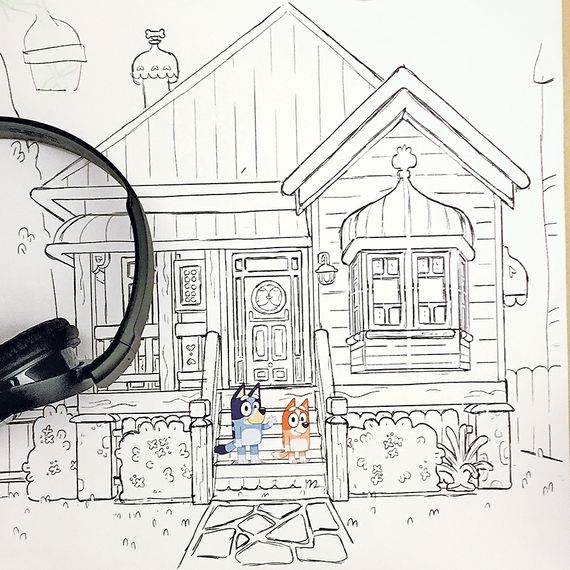
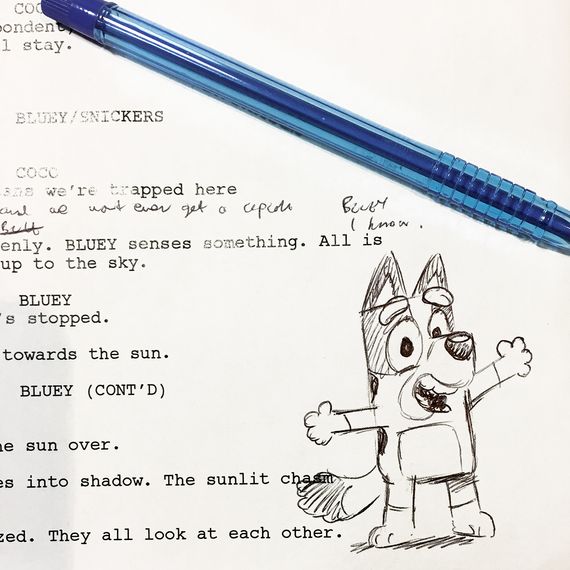
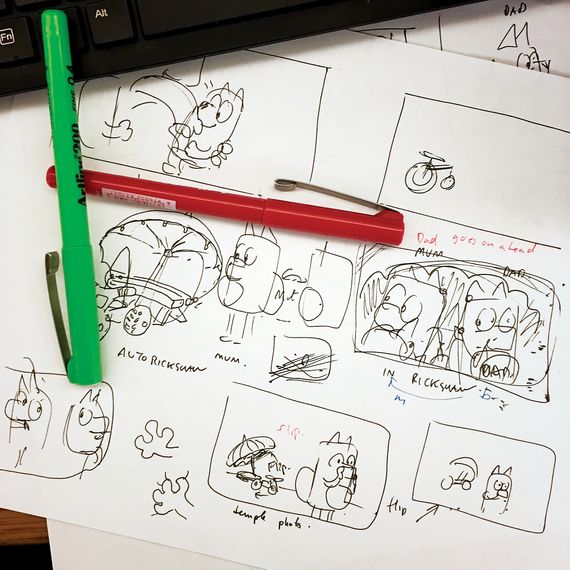
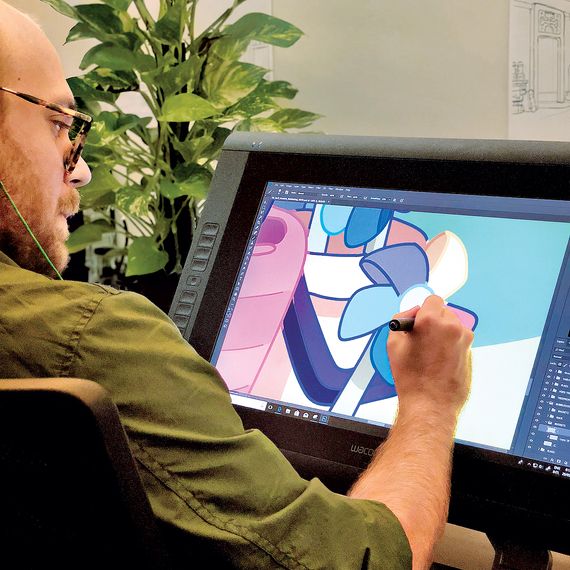
Bluey has no set rhythm for how an episode’s action will play out. This is essentially kids’-TV sacrilege. Even great shows, like Daniel Tiger’s Neighborhood or Octonauts or The Magic School Bus, are rhythmic and comforting, the nursery-school version of a grown-up’s procedural mystery. On Bluey, there is only the central idea that, somehow, it will be about a game Bluey or Bingo plays, and usually an episode will push the game toward some deeper meaning. “Dance Mode” is about the feeling of going along with something even when you’re privately unhappy. “Cafe” is an episode in which Bluey plays café with a new friend, but it is actually seven exquisite minutes on the difficulty of making friends as an adult. In “Grandad,” Chilli chides the girls about taking care of their bodies so they can grow healthy and strong, but the story takes a swift left turn into Chilli’s concern about her own aging father. This is among the handful of episodes I have walked away from in tears.
For children, Bluey’s lessons are interesting suggestions, not direct appeals. The parent side is where Bluey’s behavior modeling feels more pointed. “In reality, half the episodes when I do my story arc, the main character is Bandit or Chilli,” Brumm says. “They’re the ones learning something.” The adults make mistakes and get snappish with one another, but their imperfections are small and sweet. They are aspirational, a beacon of what life could be like if we were all more open and forgiving. The show is never judgmental, but it’s hard not to compare myself to these damnably patient cartoon dogs.
I don’t begrudge Bluey its magical imaginary of idealized parenting. It creates envy and longing and a touch of shame. It often leaves me feeling as though I come up short. But it has also made me examine my behavior as a parent. I think about the pile of abandoned babies on my desk and my unwillingness to cede to my children’s desires. And I think it may inspire me to be more capable of playing along.
If you subscribe to a service through our links, Vulture may earn an affiliate commission.



